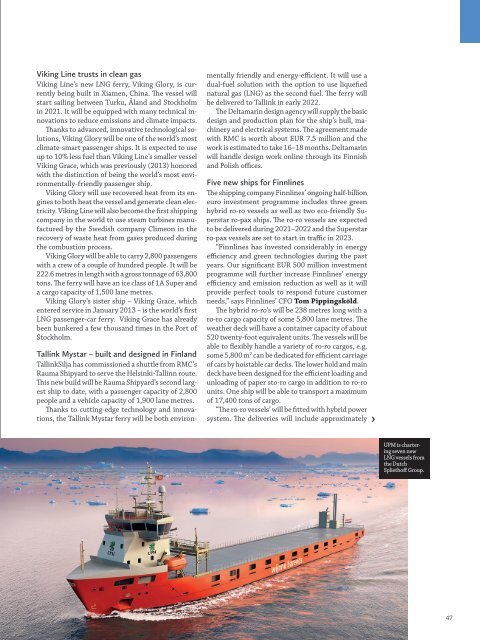You also want an ePaper? Increase the reach of your titles
YUMPU automatically turns print PDFs into web optimized ePapers that Google loves.
Viking Line trusts in clean gas<br />
Viking Line’s new LNG ferry, Viking Glory, is currently<br />
being built in Xiamen, China. The vessel will<br />
start sailing between Turku, Åland and Stockholm<br />
in <strong>2021</strong>. It will be equipped with many technical innovations<br />
to reduce emissions and climate impacts.<br />
Thanks to advanced, innovative technological solutions,<br />
Viking Glory will be one of the world’s most<br />
climate-smart passenger ships. It is expected to use<br />
up to 10% less fuel than Viking Line’s smaller vessel<br />
Viking Grace, which was previously (2013) honored<br />
with the distinction of being the world’s most environmentally-friendly<br />
passenger ship.<br />
Viking Glory will use recovered heat from its engines<br />
to both heat the vessel and generate clean electricity.<br />
Viking Line will also become the first shipping<br />
company in the world to use steam turbines manufactured<br />
by the Swedish company Climeon in the<br />
recovery of waste heat from gases produced during<br />
the combustion process.<br />
Viking Glory will be able to carry 2,800 passengers<br />
with a crew of a couple of hundred people. It will be<br />
222.6 metres in length with a gross tonnage of 63,800<br />
tons. The ferry will have an ice class of 1A Super and<br />
a cargo capacity of 1,500 lane metres.<br />
Viking Glory’s sister ship – Viking Grace, which<br />
entered service in January 2013 – is the world’s first<br />
LNG passenger-car ferry. Viking Grace has already<br />
been bunkered a few thousand times in the Port of<br />
Stockholm.<br />
Tallink Mystar – built and designed in Finland<br />
TallinkSilja has commissioned a shuttle from RMC’s<br />
Rauma Shipyard to serve the Helsinki-Tallinn route.<br />
This new build will be Rauma Shipyard’s second largest<br />
ship to date, with a passenger capacity of 2,800<br />
people and a vehicle capacity of 1,900 lane metres.<br />
Thanks to cutting-edge technology and innovations,<br />
the Tallink Mystar ferry will be both environmentally<br />
friendly and energy-efficient. It will use a<br />
dual-fuel solution with the option to use liquefied<br />
natural gas (LNG) as the second fuel. The ferry will<br />
be delivered to Tallink in early 2022.<br />
The Deltamarin design agency will supply the basic<br />
design and production plan for the ship’s hull, machinery<br />
and electrical systems. The agreement made<br />
with RMC is worth about EUR 7.5 million and the<br />
work is estimated to take 16–18 months. Deltamarin<br />
will handle design work online through its <strong>Finnish</strong><br />
and Polish offices.<br />
Five new ships for Finnlines<br />
The shipping company Finnlines’ ongoing half-billion<br />
euro investment programme includes three green<br />
hybrid ro-ro vessels as well as two eco-friendly Superstar<br />
ro-pax ships. The ro-ro vessels are expected<br />
to be delivered during <strong>2021</strong>–2022 and the Superstar<br />
ro-pax vessels are set to start in traffic in 2023.<br />
“Finnlines has invested considerably in energy<br />
efficiency and green technologies during the past<br />
years. Our significant EUR 500 million investment<br />
programme will further increase Finnlines’ energy<br />
efficiency and emission reduction as well as it will<br />
provide perfect tools to respond future customer<br />
needs,” says Finnlines’ CFO Tom Pippingsköld.<br />
The hybrid ro-ro’s will be 238 metres long with a<br />
ro-ro cargo capacity of some 5,800 lane metres. The<br />
weather deck will have a container capacity of about<br />
520 twenty-foot equivalent units. The vessels will be<br />
able to flexibly handle a variety of ro-ro cargos, e.g.<br />
some 5,800 m 2 can be dedicated for efficient carriage<br />
of cars by hoistable car decks. The lower hold and main<br />
deck have been designed for the efficient loading and<br />
unloading of paper sto-ro cargo in addition to ro-ro<br />
units. One ship will be able to transport a maximum<br />
of 17,400 tons of cargo.<br />
“The ro-ro vessels’ will be fitted with hybrid power<br />
system. The deliveries will include approximately ›<br />
UPM is chartering<br />
seven new<br />
LNG vessels from<br />
the Dutch<br />
Spliethoff Group.<br />
47

















